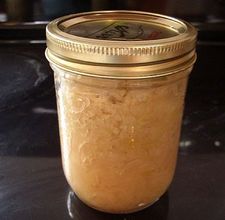 My father passed away early Sunday morning. When I shared the news with family and friends, each person I spoke to, talked about my father’s pickles and sauerkraut. Dad was the king of kraut.
My father passed away early Sunday morning. When I shared the news with family and friends, each person I spoke to, talked about my father’s pickles and sauerkraut. Dad was the king of kraut.
Memories of making kraut with my Dad, growing up in Fayetteville, New York, go back as far as I can remember. My sister and I would help him in his workshop, which was located in the unfinished portion of our basement. In this magical and mysterious spot, lay a treasure trove of wonders: my father’s darkroom, the oak barrel where he made wine, his myriad tools, and all the accoutrement necessary to make pickles and sauerkraut, the way his parents made it in the “old world,” without heat and without vinegar.
We would ball our fat little hands into fists and pound down the grated cabbage into an earthenware crock to release the juices. My eyes would survey the old shelves lining the walls, where Mason jars of green and gold gems stood like a line of soldiers, as they waited for their fermentation period to end.
When they were ready, my father would fetch a jar and, with some effort, unscrew the lid. The pickles and kraut would bubble and hiss before we scooped them out to enjoy with just about any meal my mother prepared. From my father’s perspective pickles and kraut paired with everything!
Dad also delighted in sharing his homemade delicacies. Jars upon jars found their way to the homes of relative and friends. Pickles and kraut were his “signature dishes.” Plus, my father loved to barter. I recall many times when he would use his pickled goods as currency to get a little of this and a little of that.
Even after he suffered a stroke, some 40 years ago, my father continued making pickles and kraut. When we moved him from Florida out to Seattle, and into an assisted living facility, he kept right on making them. In fact, Dave, one of the cooks even scored a few cabbages and spent a couple hours with my father, grating the cabbage and putting it into jars.
Tasting Dad’s wares was also a test of friendship. If you liked his pickles and kraut, he liked you. I think it was all of five minutes into their first meeting, that my father offered Big Papa a sampling of his goodies. I held my breath, hoping it was a “good batch.” Thankfully, it was.
There are a lot of things I will miss about my father. Many of my greatest passions in life come from him: gardening, photography, love of birds and nature. I will most certainly miss his pickles and kraut. Big Papa and I make them, but somehow, ours never seem quite as good as those my Dad made.
Abe’s Kraut
To make sauerkraut at home, you will need:
- large crock, glass, enamel or food-safe container
- Five pounds of firm, fresh green cabbage (about 2 heads)
- Food processor, madoline or cabbage shredder
- kosher salt
- a plate or something to cover kraut in crock/container
- something heavy to weight down the plate
- wooden spoon (do not use aluminum utensils in kraut making!)
Here’s how:
Shred five pounds of firm, fresh green cabbage (about two heads) in a food processor (you can also use a mandolin and I used the large cabbage grater that my Dad made). It will need to be done in batches. Dump each batch into a large bowl (or a crock if this is what you will ultimately use to ferment the cabbage) as you go, sprinkling with a total of three generous tablespoons of kosher salt, and mix it all together well. You can use a little more or a little less cabbage; just be sure to use a scant two teaspoons of kosher salt per pound of cabbage.
Pack the cabbage and any juices it has released into a crock a little at a time, pressing the cabbage down tightly with your fist as you go. If you don’t have a crock, you can use a food-safe plastic bucket; just be sure you have at least five inches of clearance above the cabbage to allow for foaming/bubbling during fermentation.
Place a clean plate over the cabbage that fits fairly snugly within the opening of the crock or bucket. Place a clean container of water (a large Mason jar works well—it should weigh a minimum of five pounds) on the plate to weight down the cabbage, and throw a clean towel over the top of the crock to keep out any dust.
Check back frequently during the first day to be sure the cabbage is releasing enough juices (the salt will pull water from the cabbage to create brine). Press on the plate/weight if necessary, and/or add more weight if the liquid doesn’t start to cover the top of the cabbage. After about six to eight hours, there should be at least an inch of juice/brine above the plate. If there isn’t, you can top off your cabbage with cooled brine composed of one and a half tablespoons of kosher salt per quart of water.
Store the crock in a spot with a temperature around 70 degrees Fahrenheit—not colder than 65 degrees or hotter than 75 degrees (a basement is ideal). Check it every few days, skimming any scum off the top. The fermentation will cause natural bubbles and foam to form and that’s okay. Rinse the plate and weight off well each time before putting them back. Keep an eye on the brine level; you may have to add more if it’s evaporating. Keep a good inch of brine above the plate as the fermentation proceeds…this is important to prevent unwanted bacteria from forming and the sauerkraut from spoiling!
Start tasting the cabbage after about a week, and ferment it to the level of sourness you like, which will take anywhere from one to four weeks. Some people prefer the milder cabbage-y taste of young kraut, while others like a more fermented flavor.
When the cabbage is fermented to your liking, transfer it and its brine to clean jars, again pressing the kraut down tightly in the jar so the juice rises above. Leave about a half inch of head space, and refrigerate. Your sauerkraut should last a few months refrigerated under brine.
Variation: Add a teaspoon or two of caraway seed for a tasty variation on your kraut. My father used to do this on occasion with a batch or two, and I quite liked it.

In memory of my father, Abe: March, 1924-January 22, 2012.
I know you’re up there making kraut like they’ve never tasted before!
Want more old-school flavor? Check out Wanderfood Wednesday.
Beth, what a lovely tribute to your dad. I’m so very sorry for your loss. Hugs…
Beth – thanks for sharing this lovely story and recipe. What a fantastic memory. I’ll never eat sauerkraut again without thinking of him!
Thank you Beth. It warms my heart to hear this.
I want some of that num-num! I love that he loved this.
He was a salt-of-the-earth renaissance sort of guy. I loved that about him too. I bet you can get some good kraut there in PA Dutch country…not Abe’s of course, but pretty darn good.
What a wonderful legacy he left you!
Aaahhh, Beth, it is the memories that make us.